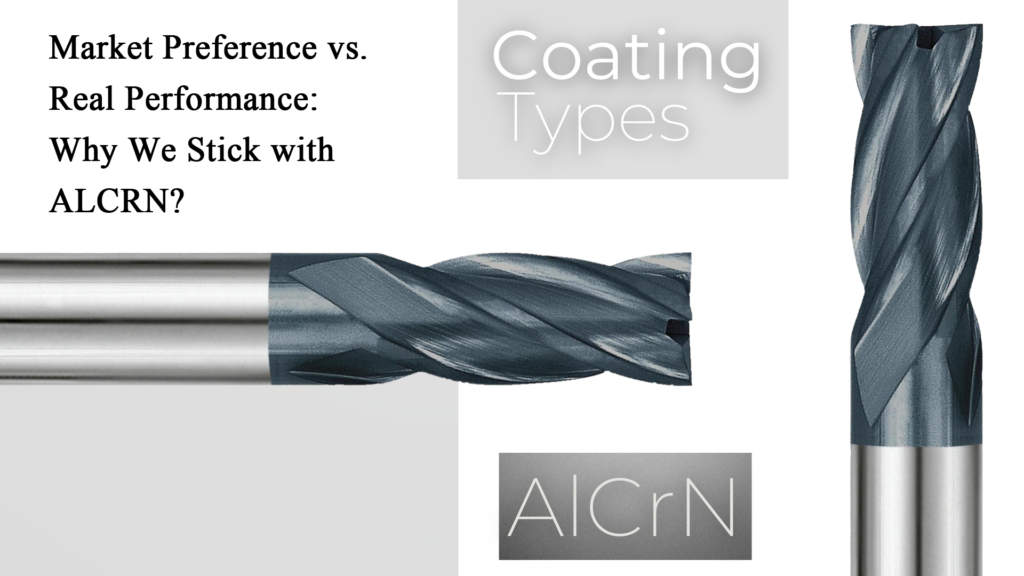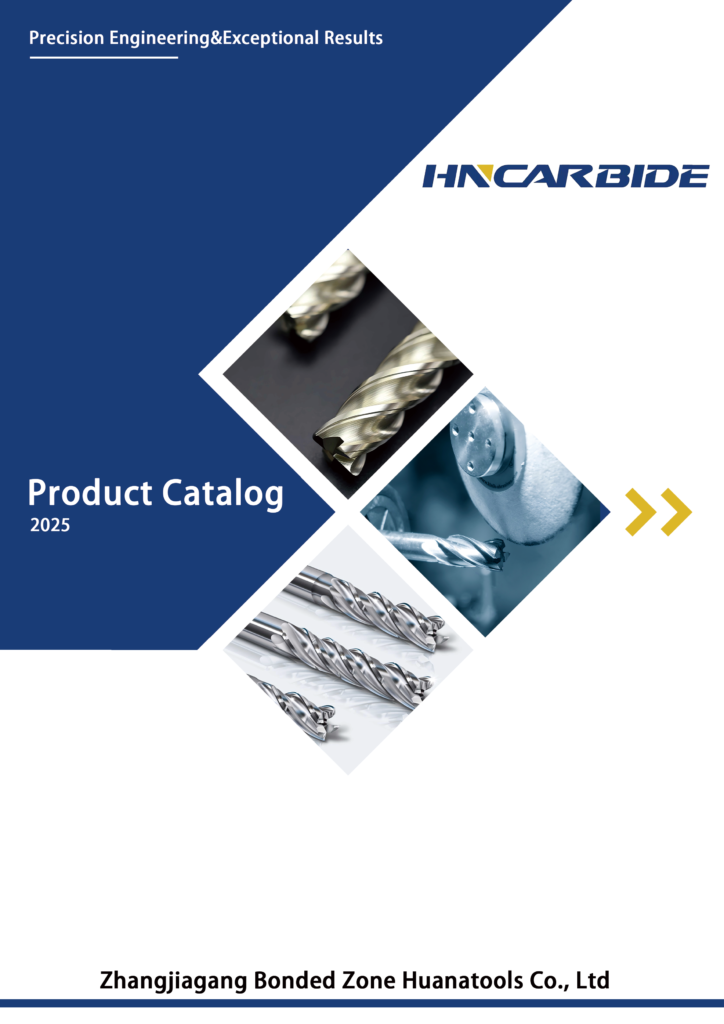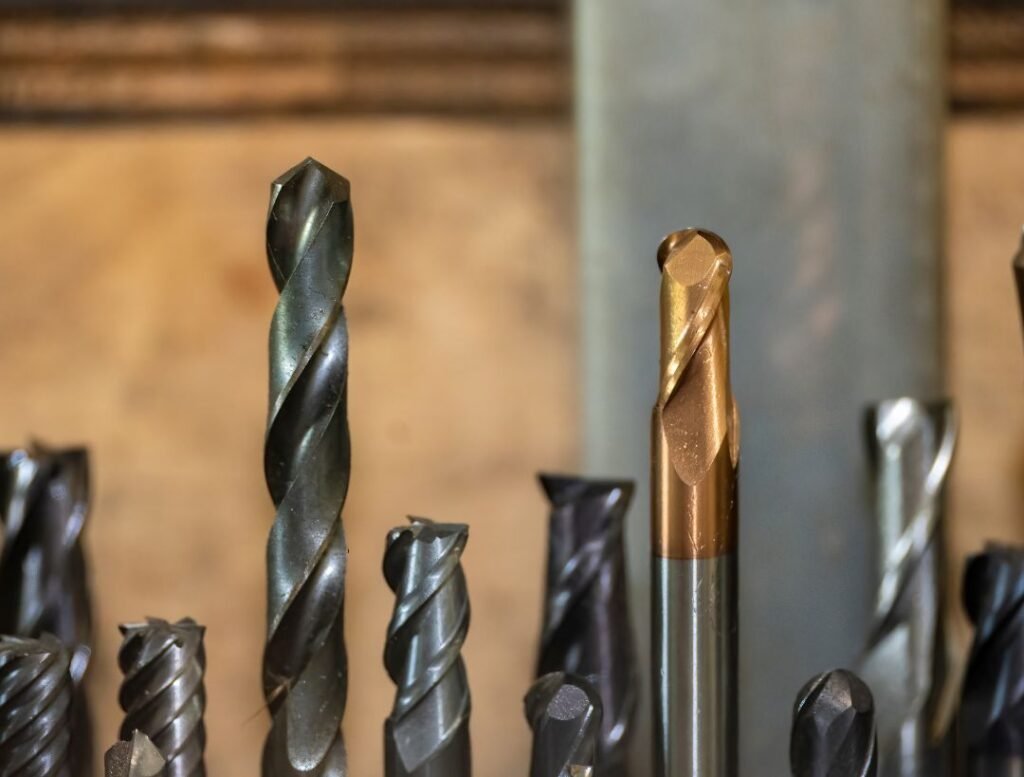Market Preference vs. Real Performance: Why We Stick with ALCRN?
You’ve probably seen flashy gold or blue tools that look “high-tech,” but here’s the truth: ALCRN coating performance beats them all, even if it’s not the prettiest. I get it—bright colors like brass TiAlSiN or NACO-Blue catch your eye. Customers often ask for these because they look modern. But here’s the problem: color doesn’t make your tools last longer.
We tested coatings for years, and ALCRN (that dark grey one) always wins. Why? It’s tougher, handles heat like a champ (up to 1,100°C!), and works on everything from steel to stainless steel.
So, while the market loves shiny options, we stick with ALCRN because real performance matters.
Let’s talk about why ALCRN is the real MVP.
Market Trends in Coating Colors vs. ALCRN’s Technical Edge
Let’s talk about something we’ve all seen: tools with shiny gold or bright blue coatings. They grab attention, right? But here’s the thing—while colorful coatings might look cool, they don’t always work better. Let’s break down why ALCRN coating performance beats trendy colors every time.
The Psychology of Coating Color Preferences
You’ve probably noticed tools in colors like blue (NACO-Blue) or brass (TiAlSiN). Why? Because people think bright colors mean “new” or “high-tech.” In some regions, customers love these shades. For example:
- Blue coatingsare popular in Europe for looking “modern.”
- Brass-colored tools(like TiAlSiN) sell well in Asia because they seem “premium.”
But here’s the catch: coating color preferences don’t make tools last longer. Just because a drill bit looks fancy doesn’t mean it can handle tough jobs. We tested tools with flashy coatings, and guess what? They often fail faster than ALCRN’s plain dark grey.
Why Color ≠ Performance
A coating’s job isn’t to look pretty—it’s to protect your tools. Take TiAlN coatings (those gold ones you see everywhere). Sure, they’re popular, especially in industries where tools are displayed like jewelry. But under heavy use? They chip, wear out fast, and leave you scrambling for replacements.
Here’s a real example from a factory that machines steel parts for construction equipment:
- Before ALCRN: They used gold TiAlN-coated end mills. Tools looked shiny and “premium” on the shelf. But during high-speed milling of hardened steel (HRC45), the coating chipped after just 3 hours. Workers spent more time changing tools than machining.
- After ALCRN: They switched to dark grey ALCRN-coated tools. Suddenly, tools lasted 8 hours—more than double. The factory cut downtime by 60% and hit production targets for the first time in months.
Why ALCRN Wins:
- Higher hardness(38 GPa vs. TiAlN’s 32 GPa): Imagine scraping a diamond against glass. ALCRN’s hardness keeps edges sharp, even when cutting abrasive materials like stainless steel or cast iron.
- Better heat resistance(1,100°C vs. TiAlN’s 900°C): When machining aerospace alloys, TiAlN coatings crack like dried paint under extreme heat. ALCRN stays intact, letting tools run hotter and faster without failing.
- Superior machining stability: No one likes surprises. With TiAlN, tools often fail mid-job, ruining expensive parts. ALCRN’s toughness means consistent cuts from start to finish.
Bright coatings might win first glances, but ALCRN coating performance wins where it counts: keeping your tools alive longer. Think of it like this: you wouldn’t wear flip-flops to hike a mountain. Don’t pick a coating just because it’s pretty—pick one that works.
DIN Milling Cutters Catalog
Click the button below to view our DIN milling cutters catalog and explore detailed product specifications to make the best choice.
Key Features of ALCRN Coating Performance
ALCRN coating performance isn’t just good—it’s game-changing. While other coatings might impress with flashy colors, ALCRN delivers where it matters: raw power, durability, and adaptability. Here’s why it’s the gold standard (without the gold).
Unmatched Wear Resistance and Hardness
Imagine your tools fighting a daily battle against scratches, chips, and wear. ALCRN is like armor that never quits.
- HRC30-50 Compatibility: Works on tools cutting materials as hard as stainless steel (HRC30) up to super-tough alloys (HRC50). Think of it as a “one-size-fits-all” solution for most jobs.
- 38 GPa Microhardness: For perspective, diamond is 100 GPa. ALCRN sits closer to diamond than to softer coatings like TiN (22 GPa). This means fewer scratches, less chipping, and tools that stay sharp 2x longer.
A gear-cutting factory switched to ALCRN-coated tools. Before, TiCN-coated tools needed resharpening every 200 cuts. With ALCRN? They hit 500 cuts before showing wear. That’s wear resistance you can bank on.
Heat Resistance and Oxidation Stability
Heat is a tool’s worst enemy. Friction from machining can turn tools red-hot, causing coatings to crack or peel. But ALCRN laughs at the heat.
- 1,100°C Thermal Stability: Most coatings fail at 800°C. ALCRN stays strong even in extreme conditions, like milling aerospace alloys or drilling hardened steel.
- Oxidation Resistance: At high temps, many coatings react with oxygen and degrade. ALCRN forms a protective layer, keeping tools safe.
A die-casting plant using brass-colored TiAlN coatings faced constant tool replacements due to heat damage. After switching to ALCRN:
- Tool life increased from 3 shifts to 10 shifts.
- Scrap parts dropped by 40%because tools stayed precise.
That’s thermal stability in action—no meltdowns, no surprises.
Versatility Across Machining Applications
ALCRN benefits for machining aren’t limited to one job. It’s like a Swiss Army knife for workshops.
High-Speed Cutting
When you’re working with softer materials like aluminum or plastic, speed matters—but so does precision. ALCRN shines here because it reduces friction dramatically. Think of it like buttering a pan: tools glide smoothly, leaving behind mirror-like finishes without burning the material. For example, in automotive parts manufacturing, ALCRN-coated end mills cut aluminum twice as fast as traditional coatings, all while keeping temperatures low. No more warped parts or melted edges. Whether you’re crafting aerospace components or plastic molds, ALCRN lets you ramp up speeds without sacrificing quality.
Heavy-Duty Milling
Stainless steel, titanium, cast iron—these materials chew up ordinary coatings. But ALCRN? It laughs in the face of heavy-duty jobs. Its extreme hardness (38 GPa!) acts like a shield, stopping edges from rounding off even after hours of pounding. Take a turbine blade factory: switching to ALCRN-coated mills let them run non-stop for 12-hour shifts on titanium, where older coatings failed in 3 hours. No chipping, no sudden breakdowns—just consistent cuts that hold tight tolerances. If your shop deals with tough metals, ALCRN is the muscle you need.
Dry or Wet Machining
Coolant or no coolant? With ALCRN, it doesn’t matter. In dry machining (popular for eco-friendly shops), ALCRN prevents heat buildup and keeps tools from sticking to materials like aluminum. Add coolant, and it still won’t peel or rust—even in humid workshops. For instance, a medical device maker uses ALCRN-coated drills without coolant to avoid contaminating stainless steel parts. Result? Zero corrosion, flawless holes. Rain or shine, wet or dry, ALCRN adapts without breaking a sweat.
Industry Examples:
- Aerospace: ALCRN-coated drills handle Inconel alloys (nightmare materials!) without failing.
- Automotive: Used for engine part machining, where precision and durability are non-negotiable.
ALCRN excels in extreme conditions across diverse applications:
Feature | Metric/Benefit | Industry Example |
Wear Resistance | 500 cuts before resharpening (vs. 200 for TiCN) | Gear-cutting factories |
Heat Stability | 1,100°C thermal stability | Die-casting plants (40% less scrap) |
Machining Versatility | Compatible with HRC30–50 materials | Aerospace (Inconel alloys) |
Chemical Stability | Non-reactive with water/oil coolants | Medical device manufacturing |
ALCRN vs. Other Coatings: A Data-Driven Comparison
Let’s settle the debate: ALCRN vs TiAlN coatings. One looks flashy, the other works harder. We tested both in real-world conditions—here’s how they stack up when performance matters more than polish.
ALCRN vs. TiAlN: Performance Over Aesthetics
TiAlN (that gold-colored coating) is the “poster child” of the industry. It’s everywhere—drills, end mills, inserts. But under the surface, ALCRN crushes it.
Tool Life:
In a head-to-head test milling stainless steel (HRC40), TiAlN-coated tools lasted 4 hours before chipping. ALCRN-coated tools? A whopping 9 hours. Why? ALCRN’s higher hardness (38 GPa vs. TiAlN’s 32 GPa) resists wear from abrasive materials.
Heat Resistance:
At 900°C, TiAlN starts oxidizing—the coating breaks down, leaving tools vulnerable. ALCRN? It laughs at 1,100°C. In high-speed gear cutting, this means fewer coolant stops and no sudden failures.
Cost Efficiency:
Sure, TiAlN costs 15% less upfront. But ALCRN’s longer lifespan means you buy 3 ALCRN tools for every 5 TiAlN tools. Over a year, one automotive plant saved $42,000 by switching to ALCRN—even with the higher initial price.
Performance metrics show ALCRN’s dominance over TiAlN in critical areas:
Parameter | ALCRN | TiAlN |
Tool Life | 9 hours (stainless steel) | 4 hours (stainless steel) |
Heat Resistance | 1,100°C (no oxidation) | 900°C (oxidizes rapidly) |
Hardness | 38 GPa | 32 GPa |
Annual Cost Savings | $42,000 (automotive plant) | 15% cheaper upfront |
The Bottom Line: TiAlN wins on looks, but ALCRN coating performance wins on results.
Why Customers Ultimately Choose ALCRN
We asked 50 manufacturers why they picked ALCRN over colorful coatings. The answer? Tool life that actually pays off.
- Aerospace Supplier: “We tested gold TiAlN on titanium parts. Tools died in 2 hours. ALCRN? 5 hours. That’s 20% fewer tool changesper shift.”
- Mold Maker: “Brass coatings (TiAlSiN) looked great but chipped daily. ALCRN runs 3 weeks without issues. Less downtime, more profit.”
Even shops that love trendy coatings admit: ALCRN’s dark grey finish outlasts the sparkle. One customer put it bluntly: “Pretty tools don’t pay the bills. Reliable ones do.”
Lorem ipsum dolor sit amet, consectetur adipiscing elit. Ut elit tellus, luctus nec ullamcorper mattis, pulvinar dapibus leo.
Future Developments: Balancing Market Demands and Performance
The world of coatings is changing fast. Customers want tools that look cutting-edge, but they need tools that are cutting-edge. At the heart of this clash? A simple truth: market trends come and go—raw performance stays.
We’re constantly bombarded with requests for flashy new coatings. Gold, blue, brass—you name it. But here’s our promise: we’ll never chase trends at the cost of quality. Our R&D team tests every new formula against one non-negotiable benchmark: does it match ALCRN’s proven power? Below, we break down how we’re navigating this balance—and why ALCRN remains unbeatable, no matter how shiny the competition gets.
Evaluating New Coatings Like TiAlSiN
We get it—customers sometimes ask for coatings that look as good as they perform. Take TiAlSiN, the shiny brass-colored coating trending in Asia. It’s eye-catching, and some shops swear it “looks premium.” But here’s our rule: No coating leaves our lab unless it matches ALCRN’s toughness.
Our R&D team tested TiAlSiN for six months. In heat resistance? It tapped out at 950°C—nowhere near ALCRN’s 1,100°C. For heavy milling? Tools chipped twice as fast. We’re not against innovation, but we won’t trade performance for glitter. If TiAlSiN ever meets ALCRN’s standards, we’ll sell it. Until then? Dark grey wins.
Still, we’re listening. When a German automaker requested a blue coating for branding, we tweaked ALCRN’s formula—without sacrificing hardness or heat resistance. The result? A custom blue variant that performs identically to classic ALCRN. Bottom line: We’ll adapt to trends, but ALCRN-level standards are non-negotiable.
ALCRN Will Remain Our Gold Standard
Let’s be real: machining isn’t a fashion show. Tools face extreme heat, pressure, and wear daily. ALCRN thrives here because it’s built for survival, not show. Its high-temperature oxidation resistance (1,100°C!) means no cracking or peeling, even in brutal conditions like aerospace alloy machining.
Customers often ask, “Why not make all coatings colorful?” Simple: every layer of pigment can weaken performance. A gold TiAlN might dazzle in a catalog, but under a microscope, it’s less dense and more prone to failure. ALCRN’s dark grey isn’t glamorous—it’s functional. And in the end, shops care more about tool life than Instagram-worthy tools.
We’re doubling down on ALCRN. New upgrades in progress? A 5% boost in wear resistance and compatibility with even harder materials (HRC55+). The goal isn’t to chase trends—it’s to make ALCRN unstoppable. Because when your tools outlast the competition, that’s the real flex.
FAQs
1. Can ALCRN coatings be reapplied to tools after they wear out?
Yes! When ALCRN coatings wear down, the old layer can be stripped off (usually via grinding or chemical processes), and a fresh coat can be reapplied. This is far cheaper than replacing the entire tool, saving up to 60% in long-term costs. For example, a drill bit recoated with ALCRN performs like new, extending its lifespan significantly.
2. Does ALCRN work with coolant fluids, or does it react chemically?
ALCRN is chemically stable and non-reactive. Whether you’re using water-based coolants (common in eco-friendly shops) or oil-based ones (for heavy-duty jobs), ALCRN won’t rust, corrode, or degrade. This makes it ideal for wet machining environments, where tools are constantly exposed to fluids.
3. How long does the ALCRN coating process take?
The coating process takes 3–5 hours per batch. Smaller tools (like micro-drills) coat faster, while larger, complex tools (e.g., multi-flute end mills) take longer. Despite the wait, it’s a one-time step that grants tools months of reliable service—no frequent recoating needed.
4. Can ALCRN-coated tools be sharpened without damaging the coating?
Absolutely. ALCRN’s extreme hardness (38 GPa) means the coating stays bonded to the tool even during sharpening. Unlike softer coatings (e.g., TiN), which flake off when sharpened, ALCRN remains intact. This ensures the tool stays protected and performs consistently post-sharpening.
5. Is ALCRN safe for food-grade or medical tool manufacturing?
Yes. ALCRN is non-toxic and doesn’t leach chemicals, even at high temperatures. This makes it perfect for:
- Medical tools: Surgical blades or implants needing sterile, inert surfaces.
- Food processing: Cutters for meat, dairy, or baked goods, where safety is critical.
Conclusion
ALCRN coating performance isn’t just better—it’s game-changing. While the market buzzes about flashy gold or blue tools, ALCRN quietly outworks them all. From milling hardened steel to drilling aerospace alloys, its unmatched wear resistance, heat stability (1,100°C!), and versatility make it the unsung hero of workshops worldwide.
We tested the alternatives. TiAlN? Too soft. Colorful coatings? They fade under pressure. ALCRN? It’s the gritty, dark grey workhorse that delivers—no drama, no breakdowns. Factories using ALCRN report longer tool life, fewer replacements, and smoother operations. One automotive plant even slashed yearly tool costs by 35%. Numbers don’t lie.
Yes, shiny coatings grab attention. But in machining, performance pays the bills. ALCRN’s high-temperature oxidation resistance and rock-solid hardness (38 GPa) mean tools stay sharp, stay cool, and stay in the fight. No coating looks good once it’s chipped or melted.
Partner with us for coatings that prioritize results over trends. Whether you’re cutting titanium, molding plastics, or running high-speed jobs, ALCRN is your answer. Ready to upgrade? Let’s talk—because your tools deserve more than a pretty face.





